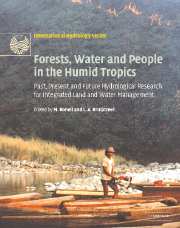 Forests, Water and People in the Humid Tropics
Forests, Water and People in the Humid Tropics Book contents
- Frontmatter
- Contents
- List of contributors
- Foreword
- Preface
- Acknowledgements
- Symposium and Workshop
- Introduction
- Part I Current trends and perspectives on people–land use–water issues
- Part II Hydrological processes in undisturbed forests
- Part III Forest disturbance, conversion and recovery
- 19 Natural disturbances and the hydrology of humid tropical forests
- 20 Spatially significant effects of selective tropical forestry on water, nutrient and sediment flows: a modelling-supported review
- 21 Effects of shifting cultivation and forest fire
- 22 Soil and water impacts during forest conversion and stabilisation to new land use
- 23 Large-scale hydrological impacts of tropical forest conversion
- 24 Forest recovery in the humid tropics: changes in vegetation structure, nutrient pools and the hydrological cycle
- 25 The hydrological and soil impacts of forestation in the tropics
- 26 The potential of agroforestry for sustainable land and water management
- Part IV New methods for evaluating effects of land-use change
- Part V Critical appraisals of best management practices
- Conclusion: Forests, water and people in the humid tropics: an emerging view
- Plate section
- References
23 - Large-scale hydrological impacts of tropical forest conversion
from Part III - Forest disturbance, conversion and recovery
Published online by Cambridge University Press: 12 January 2010
- Frontmatter
- Contents
- List of contributors
- Foreword
- Preface
- Acknowledgements
- Symposium and Workshop
- Introduction
- Part I Current trends and perspectives on people–land use–water issues
- Part II Hydrological processes in undisturbed forests
- Part III Forest disturbance, conversion and recovery
- 19 Natural disturbances and the hydrology of humid tropical forests
- 20 Spatially significant effects of selective tropical forestry on water, nutrient and sediment flows: a modelling-supported review
- 21 Effects of shifting cultivation and forest fire
- 22 Soil and water impacts during forest conversion and stabilisation to new land use
- 23 Large-scale hydrological impacts of tropical forest conversion
- 24 Forest recovery in the humid tropics: changes in vegetation structure, nutrient pools and the hydrological cycle
- 25 The hydrological and soil impacts of forestation in the tropics
- 26 The potential of agroforestry for sustainable land and water management
- Part IV New methods for evaluating effects of land-use change
- Part V Critical appraisals of best management practices
- Conclusion: Forests, water and people in the humid tropics: an emerging view
- Plate section
- References
Summary
INTRODUCTION
Hydrologists are facing important changes in the direction of their science. New tools, non-traditional datasets and a better understanding of the connection between land-surface hydrology and the rest of the climate system are being developed. Changes are so fundamental that a new agenda for land surface hydrology research has been proposed (Entekhabi et al., 1999).
One of the major challenges is related to large-scale hydrology. Part of this challenge is to reconcile the differences between two sciences. Large-scale hydrology is being studied typically by scientists with a background in hydrology or the atmospheric sciences, and the historical approach of each discipline is clearly present. Table 23.1 shows the different definitions of the spatial scales in common use. Here, we consider large-scale to be the scale between 100 and 10 000 km, a mix of the large catchment and continental scales of hydrology and a mix of synoptic and large scales found in atmospheric sciences.
Hydrologists and atmospheric scientists advanced into the new research field of large-scale hydrology a few decades ago: hydrologists scaled up their methods, atmospheric scientists scaled down their techniques. Of course there were conflicts caused by the different assumptions, jargon, orientations and methodologies used by the two sciences because of decades of separate development. Even so, the latter is hardly the beginning of the difficulties: in one of the pioneer essays in this area, Eagleson (1986) pointed out that large-scale hydrology has two characteristics that make it unique: interdisciplinarity and the presence of strong feedbacks.
- Type
- Chapter
- Information
- Forests, Water and People in the Humid TropicsPast, Present and Future Hydrological Research for Integrated Land and Water Management, pp. 590 - 597Publisher: Cambridge University PressPrint publication year: 2005
References
- 24
- Cited by


